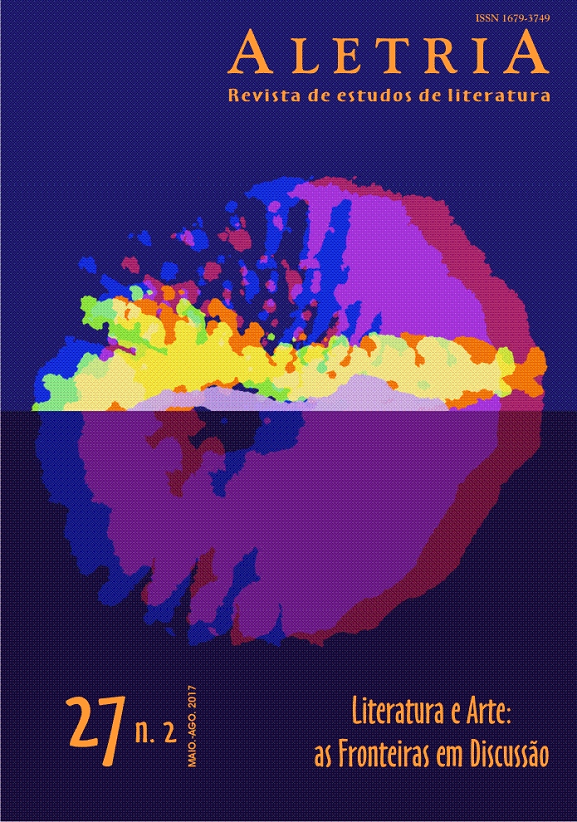Blurring the boundaries – ekphrasis as a fold
DOI:
https://doi.org/10.17851/2317-2096.27.2.97-111Keywords:
ekphrasis, fold, word and image relationsAbstract
The article provides a new theoretical perspective on ekphrasis, a very old rhetorical and literary device. The new approach applies the morphology of the fold, a notion examined by Gottfried Willhelm Leibniz in the 17th century and recently discussed by Gilles Deleuze and Anna Munster, to present ekphrasis as a continuum of word and image rather than the opposition of the verbal and the visual. The hybrid nature of ekphrasis and the dynamic tensions between its verbal and visual components allow for the blurring of the boundaries between word and image.
Downloads
References
CLÜVER, Claus. Ekphrasis Reconsidered: On Verbal Representations of Non Verbal Texts. In: LAGERROTH, Ulla-Britta (Ed.). Interarts Poetics: Essays on the Interpretations of the Arts and Media. Amsterdam: Rodopi, 1997. p. 19-33.
DELEUZE, Gilles. Cinema 2: The Time-Image. Trans. Hugh Tomlinson, Robert Galeta. Minneapolis: University of Minnesota Press, 1989.
DELEUZE, Gilles. The Fold. Trans. Jonathan Strauss. Yale French Studies, New Haven, n. 80, p. 227-247, 1991.
DELEUZE, Gilles. The Fold: Leibniz and the Baroque. Trans. Tom Conley. London: The Athlone Press, 1993.
EGGINTON, William. The Theater of Truth: The Ideology of (Neo)Baroque Aesthetics. Stanford: Stanford UP, 2010.
FÜHRER, Heidrun; BANASZKIEWICZ, Bernadette. The Trajectory of Ancient Ekphrasis. In: JEDLIČKOVÁ, Alice. On Description. Prague: Akropolis, 2014. p. 45-75.
HEFFERNAN, James. Ekphrasis and Representation. New Literary History, Baltimore, v. 22, n. 2, p. 297-316, Spring 1991. DOI: https://doi.org/10.2307/469040.
HEFFERNAN, James. Entering the Museum of Words. WAGNER, Peter (Ed.). Icons, Texts, Iconotexts: Essays on Ekphrasis and Intermediality. Berlin, New York: Walter de Gruyter, 1996. p. 262-280. DOI: https://doi.org/10.1515/9783110882599.262.
HEFFERNAN, James. Museum of Words: The Poetics of Ekphrasis from Homer to Ashbery. Chicago, London: The University of Chicago Press, 1993.
KESTNER, Joseph. Ekphrasis as Frame in Longus’ “Daphnis and Chloe.” The Classical World, Baltimore, v. 67, n. 3, p. 166-171, Dec. 1973-Jan. 1974.
LINDHÉ, Cecilia. “A Visual Sense Is Born in the Fingertips”: Towards a Digital Ekphrasis. Digital Humanites Quarterly, Boston, v. 7, n. 1, 2013. Available at: http://www.digitalhumanities.org/dhq/vol/7/1/000161/000161.html. Accessed on: 20 Aug. 2017.
MELTZER, Françoise. Salome and the Dance of Writing: Portraits of Mimesis in Literature. Chicago: University of Chicago Press, 1987. DOI: https://doi.org/10.7208/chicago/9780226519654.001.0001.
MITCHELL, William John Thomas. Picture Theory: Essays on Verbal and Visual Representation. Chicago: University of Chicago Press, 1994.
MUNSTER, Anna. Materializing New Media: Embodiment in Information Aesthetics. Hanover, London: UP of New England, 2006.
SEPPI, Angelika. Simply Complicated: Thinking in Folds. FRIEDMAN, Michael; SCHÄFFNER, Wolfgang (Ed.). On Folding: Towards a New Field of Interdisciplinary Research. Bielefeld: Transcript Verlag, 2016. p. 49-76. DOI: https://doi.org/10.14361/9783839434048-003.
SMITH, Mack. Literary Realism and the Ekphrastic Tradition. University Park: The Pennsylvania State UP, 1995.
TEYSSOT, Georges. Baroque Topographies. Assemblage, Cambridge, MA, n. 41, p. 79, Apr. 2000.
WAGNER, Peter (Ed.). Icons, Texts, Iconotexts: Essays on Ekphrasis and Intermediality. Berlin, New York: Walter de Gruyter, 1996. DOI: https://doi.org/10.1515/9783110882599.
WEST-PAVLOV, Russell. Space as Theory: Kristeva, Foucault, Deleuze. Amsterdam, New York: Rodopi, 2009.
YACOBI, Tamar. Pictorial Models and Narrative Ekphrasis. Poetics Today, Durham, v. 16, n. 4, p. 599-649, Winter 1995.
Downloads
Additional Files
Published
How to Cite
Issue
Section
License
Copyright (c) 2017 Dominika Bugno-Narecka (Autor)

This work is licensed under a Creative Commons Attribution 4.0 International License.
Authors who publish with this journal agree to the following terms:Authors retain copyright and grant the journal right of first publication with the work simultaneously licensed under a Creative Commons Attribution Non-Commercial No Derivatives License that allows others to share the work with an acknowledgement of the work's authorship and initial publication in this journal.Authors are able to enter into separate, additional contractual arrangements for the non-exclusive distribution of the journal's published version of the work (e.g., post it to an institutional repository or publish it in a book), with an acknowledgement of its initial publication in this journal.Authors are permitted and encouraged to post their work online (e.g., in institutional repositories or on their website) prior to and during the submission process, as it can lead to productive exchanges, as well as earlier and greater citation of published work (See The Effect of Open Access).





